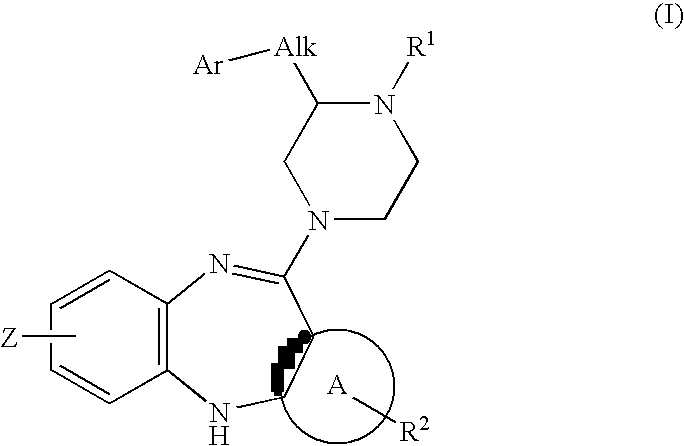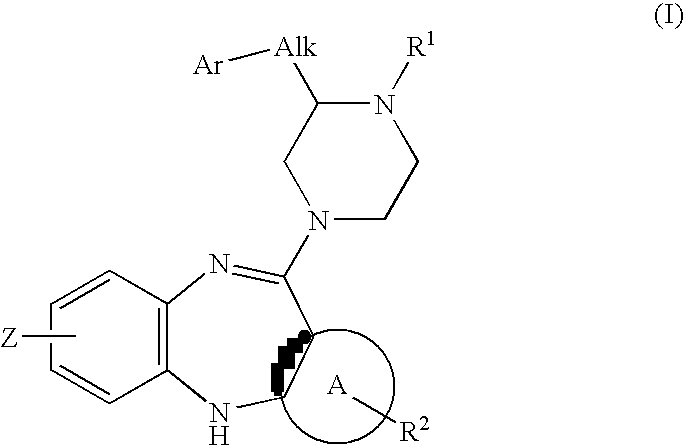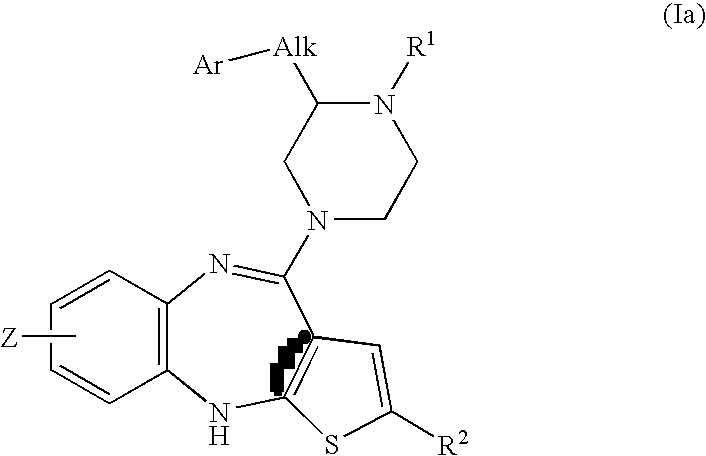Piperazine substituted aryl benzodiazepines and their use as dopamine receptor antagonists for the treatment of psychotic disorders
a technology of dopamine receptor and piperazine, which is applied in the direction of heterocyclic compound active ingredients, drug compositions, biocides, etc., can solve the problems of insufficient treatment of negative symptoms, inducing significant adverse events, and high cost to society
- Summary
- Abstract
- Description
- Claims
- Application Information
AI Technical Summary
Problems solved by technology
Method used
Image
Examples
example 1
3-(S)-Phenethyl-piperazine-2,5-dione
[0163] Add sequentially, glycine methyl ester hydrochloride (4.51 g, 35.9 mmol), 1-ethyl-(3-dimethyl-aminopropyl)carbodiimide hydrochloride (8.23 g, 42.9 mtnol), 1-hydroxybenzotriazole monohydrate (5.81 g, 43.0 mmol), and triethylamine (10.0 mL, 71.7 mmol) to a solution of 2-tert-butoxycarbonylamino-4-(S)-phenyl-butyric acid (10.0 g, 35.8 mmol) in methylene chloride (30 mL) at 0° C. Stir the mixture at room temperature overnight and concentrate. Partition the residue between ethyl acetate and aqueous 2N HCl (100 mL). Wash the organic layer with 10% K2CO3, dry (MgSO4), and concentrate to provide the (2-tert-butoxycarbonylamino-4-(S)-phenyl-butyrylamino)-acetic acid methyl ester as a clear oil (12.3 g, 98%): 1H NMR (CDCl3): δ1.45 (s, 9H), 1.95 (m, 1H), 2.20 (m, 1H), 2.71 (t, 2H), 3.76 (s, 3H), 4.04 (d, 2H), 4.16 (m, H), 5.00 (d, 1H), 6.57 (t, 1H), 7.17-7.32 (m, 5H).
[0164] Add trifluoroacetic acid (30 mL) to (2-tert-butoxycarbonylamino-4-(S)-phenyl...
example 24
2-(S)-Phenethyl-piperazine
[0167] Add 3-(S)-phenethyl-piperazine-2,5-dione (2.5 g, 11 mmol) portionwise to lithium aluminum hydride (1.75 g, 46 mmol) in THF (46 mL). Reflux the resulting suspension for an hour and cool to 0° C. Add sodium sulfate decahydrate careflilly until hydrogen evolution ceases and stir the mixture for an additional three hours at room temperature and filter. Wash the solids with THF several times. Combine the filtrates, concentrate, and recrystallize the residue with THF / pentane to afford 2-(S)-phenethyl-piperazine as white crystals (1.9 g, 90%): mp 114-115° C.; 1H NMR (CDCl3): δ1.58-1,70 (m, 2H), 2.41 (dd, 1H), 2.58-3.02 (m, 8H), 7.16-7.30 (m, 5H); MS (APCI) m / z (rel intensity) 191 (100).
[0168] By a similar method to Example 24, using the appropriate starting materials, the following piperazines were prepared and isolated as the (S) isomer except where noted below:
No:ArAlkData25CH2Phmp 65-67° C.; 1H NMR(CDCl3): δ2.47-2.57(m, 2H), 2.67-3.00(m, 7H), 7.16-7....
example 58
2-(S)-(4-Bromo-benzyl)-pipierazine
[0169] Add dropwise a 1M solution of BH3.THF (183 mL, 183 mmol) to 3-(S)-(4-bromo-benzyl)-piperazine-2,5-dione (6.5 g, 23 mmol) in 100 mL of dry THF at ambient temperature. Stir for an hour then heat to reflux for two days and cool down to 0° C. Add slowly a 12% hydrobromic acid solution in acetic acid and stir overnight. Isolate the precipitate, wash it with ethyl acetate and hexanes and dry it to yield the di-hydrobromic salt as a white solid. Add to this solid a saturated sodium bicarbonate in water and extract with a solution of dichloromethane and isopropyl alcohol (75 / 25). Dry over magnesium sulfate and evaporate the solvent to yield the title compound (4.3 g, 73%) as a white powder: mp=91-93° C.; 1H NMR (CDCl3): δ2.45-2.52 (m, 2H), 2.64 (dd, 1H), 2.68-2.75 (m, 2H), 2.82 (m, 1H), 2.88-2.97 (m, 3H), 7.08 (d, 2H), 7.42 (d, 2H); MS (APCI) m / z (rel intensity) 255 (100), 257 (100).
PUM
| Property | Measurement | Unit |
|---|---|---|
| Fraction | aaaaa | aaaaa |
| Fraction | aaaaa | aaaaa |
| Time | aaaaa | aaaaa |
Abstract
Description
Claims
Application Information
 Login to View More
Login to View More - R&D
- Intellectual Property
- Life Sciences
- Materials
- Tech Scout
- Unparalleled Data Quality
- Higher Quality Content
- 60% Fewer Hallucinations
Browse by: Latest US Patents, China's latest patents, Technical Efficacy Thesaurus, Application Domain, Technology Topic, Popular Technical Reports.
© 2025 PatSnap. All rights reserved.Legal|Privacy policy|Modern Slavery Act Transparency Statement|Sitemap|About US| Contact US: help@patsnap.com



